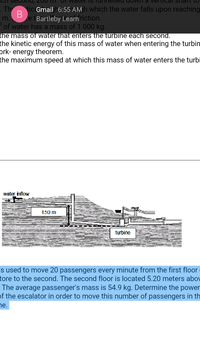
College Physics
11th Edition
ISBN: 9781305952300
Author: Raymond A. Serway, Chris Vuille
Publisher: Cengage Learning
expand_more
expand_more
format_list_bulleted
Concept explainers
Question
The diagram below represents how water is funnelled into a pipe and directed to aturbine at a hydroelectric power plant. The force of the falling water rotates theturbine. Each second, 200 m3 of water is funnelled down a vertical shaft to the turbine below. The vertical height through which the water falls upon reaching the turbine is 150 m. Ignore the effects of friction.
NOTE: One m3 of water has a mass of 1 000 kg.
Calculate the mass of water that enters the turbine each second.
Calculate the kinetic energy of this mass of water when entering the turbine. Use the work- energy theorem.
Calculate the maximum speed at which this mass of water enters the turbine.

Transcribed Image Text:ICIT secOna,
OT Waler is Tui
tical SiTait to
. Th tic Gmail h6:55 AM h which the water falls upon reaching
e tBartleby Learn riction.
of water has a mass of 1 000 kg.
m.
the mass of water that enters the turbine each second.
the kinetic energy of this mass of water when entering the turbin
prk- energy theorem.
the maximum speed at which this mass of water enters the turbi
water inflow
150 m
turbine
s used to move 20 passengers every minute from the first floor
tore to the second. The second floor is located 5.20 meters abov
The average passenger's mass is 54.9 kg. Determine the power
of the escalator in order to move this number of passengers in th
ne.
Expert Solution
This question has been solved!
Explore an expertly crafted, step-by-step solution for a thorough understanding of key concepts.
This is a popular solution
Trending nowThis is a popular solution!
Step by stepSolved in 4 steps with 1 images

Knowledge Booster
Learn more about
Need a deep-dive on the concept behind this application? Look no further. Learn more about this topic, physics and related others by exploring similar questions and additional content below.Similar questions
- Don't use chat gpt plz Chatgpt means downvotearrow_forwardA trough full of water is 20ft. long and its cross section is in the shape of an isosceles triangle 4ft. wide across the topand 4ft. deep. How much is the work done in pumping all the water out of the trough over the top?arrow_forwardAn aquarium 11m long, 2m wide, and 9m deep is full of water. The density of water is 1000kg/m3 and the force of gravity is 9.8m/s2 a) Find the work needed to pump all of the water out of the aquarium b) Find the work needed to pump half of the water out of the aquarium.arrow_forward
- a conical tank with height 10 and radius 2 is filled to the top woth a liquid weighing 15 n/m^3 how much work is spent pumping all of the liquid out of the tank through the toparrow_forwardHoover Dam on the Colorado River is the highest dam in the United States at 221 m, with an output of 1300 MW. The dam generates electricity with water taken from a depth of 106 m and an average flow rate of 640 m/s. (a) Calculate the power in this flow in watts. (b) What is the ratio of this power to the facility's average of 680 MW?arrow_forward
arrow_back_ios
arrow_forward_ios
Recommended textbooks for you
 College PhysicsPhysicsISBN:9781305952300Author:Raymond A. Serway, Chris VuillePublisher:Cengage Learning
College PhysicsPhysicsISBN:9781305952300Author:Raymond A. Serway, Chris VuillePublisher:Cengage Learning University Physics (14th Edition)PhysicsISBN:9780133969290Author:Hugh D. Young, Roger A. FreedmanPublisher:PEARSON
University Physics (14th Edition)PhysicsISBN:9780133969290Author:Hugh D. Young, Roger A. FreedmanPublisher:PEARSON Introduction To Quantum MechanicsPhysicsISBN:9781107189638Author:Griffiths, David J., Schroeter, Darrell F.Publisher:Cambridge University Press
Introduction To Quantum MechanicsPhysicsISBN:9781107189638Author:Griffiths, David J., Schroeter, Darrell F.Publisher:Cambridge University Press Physics for Scientists and EngineersPhysicsISBN:9781337553278Author:Raymond A. Serway, John W. JewettPublisher:Cengage Learning
Physics for Scientists and EngineersPhysicsISBN:9781337553278Author:Raymond A. Serway, John W. JewettPublisher:Cengage Learning Lecture- Tutorials for Introductory AstronomyPhysicsISBN:9780321820464Author:Edward E. Prather, Tim P. Slater, Jeff P. Adams, Gina BrissendenPublisher:Addison-Wesley
Lecture- Tutorials for Introductory AstronomyPhysicsISBN:9780321820464Author:Edward E. Prather, Tim P. Slater, Jeff P. Adams, Gina BrissendenPublisher:Addison-Wesley College Physics: A Strategic Approach (4th Editio...PhysicsISBN:9780134609034Author:Randall D. Knight (Professor Emeritus), Brian Jones, Stuart FieldPublisher:PEARSON
College Physics: A Strategic Approach (4th Editio...PhysicsISBN:9780134609034Author:Randall D. Knight (Professor Emeritus), Brian Jones, Stuart FieldPublisher:PEARSON

College Physics
Physics
ISBN:9781305952300
Author:Raymond A. Serway, Chris Vuille
Publisher:Cengage Learning

University Physics (14th Edition)
Physics
ISBN:9780133969290
Author:Hugh D. Young, Roger A. Freedman
Publisher:PEARSON

Introduction To Quantum Mechanics
Physics
ISBN:9781107189638
Author:Griffiths, David J., Schroeter, Darrell F.
Publisher:Cambridge University Press

Physics for Scientists and Engineers
Physics
ISBN:9781337553278
Author:Raymond A. Serway, John W. Jewett
Publisher:Cengage Learning

Lecture- Tutorials for Introductory Astronomy
Physics
ISBN:9780321820464
Author:Edward E. Prather, Tim P. Slater, Jeff P. Adams, Gina Brissenden
Publisher:Addison-Wesley

College Physics: A Strategic Approach (4th Editio...
Physics
ISBN:9780134609034
Author:Randall D. Knight (Professor Emeritus), Brian Jones, Stuart Field
Publisher:PEARSON